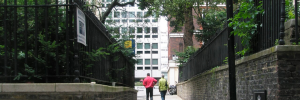The cataclysmic event of the Great Fire of London in 1666 irrevocably transformed the face of the city, decimating approximately 80% of the urban area. Fanned by robust south-eastern winds, this immense conflagration posed an unparalleled threat that left an indelible mark on the metropolis. Interestingly, the same forceful winds hindered the Dutch and English fleets from clashing in the English Channel just a night prior to the onset of the fire, demonstrating their formidable strength.
Understanding the influence of wind direction is pivotal to grasp the scale of the disaster. The winds blew the flames away from the Thames, eliminating any chance of the river serving as a natural fire barrier. The modern cityscape provides evidence of the fire’s trajectory, with only the northeastern segment of the city, shielded from the wind’s path, remaining unscathed. Remarkably, it is here that historical treasures such as the pre-fire edifices of St Andrew Undershaft, St Katharine Cree, and St Helen’s Bishopsgate can still be found.
Understanding the Devastation: The Great Fire of London in 1666
Have you ever pondered the reasons behind the catastrophic damage caused by the Great Fire of London in 1666? Let’s dissect the factors that contributed to this monumental disaster.
The Fire’s Immense Impact
Why was the Great Fire of London in 1666 exceptionally destructive? The answer lies in the convergence of several key factors that fanned the flames of devastation.
Fierce Winds and Dry Summer: A Deadly Combination
One crucial factor was the intense southeastern wind, which exacerbated the spread of the fire. Coupled with an unusually dry summer that year, the city’s predominantly wooden buildings were vulnerable and readily combustible.
Structural Vulnerabilities and Inadequate Fire-Fighting Measures
Beyond these environmental conditions, structural weaknesses within the city’s architecture made London particularly susceptible to such a catastrophe. Despite having rudimentary fire-fighting equipment, the city was ill-prepared to deal with a disaster of this magnitude.
A City Rebuilt from the Ashes
In the aftermath, the city undertook significant steps to mitigate future disasters, such as implementing building regulations and devising plans for wider streets. The Great Fire’s legacy, while tragic, has shaped the London we know today.
In conclusion, the unique combination of factors – from fierce winds and a dry summer to structural weaknesses and inadequate fire-fighting measures – led to the immense devastation caused by the Great Fire of London in 1666. Through understanding these reasons, we gain a deeper appreciation of how this historical event has indelibly shaped the face of modern London.
The Human Factor: Lord Mayor Thomas Bloodworth’s Misjudgment
An often overlooked but critical aspect of the Great Fire of London’s progression was the role played by humans, particularly the Lord Mayor, Thomas Bloodworth. His initial underestimation of the fire and subsequent inaction allowed the blaze to spread uncontrollably.
Surviving Treasures Amid Destruction: Churches of London
While the fire ravaged much of the city, a few key historical structures remarkably survived. These include pre-fire churches in the north-eastern part of the city, such as St Andrew Undershaft, St Katharine Cree, and St Helen’s Bishopsgate. These surviving structures offer glimpses of London’s past, preserved amidst the sweeping transformation brought on by the Great Fire.
London’s Resilience: The Surprising Paradox
The Great Fire of London was indeed a calamity, but it also raises an intriguing question: Why had a disaster of such magnitude not occurred sooner? London had faced fires before 1666, albeit on a smaller scale, indicating a certain level of preparedness. But the fire of 1666 was unprecedented, underscoring the city’s vulnerability yet also demonstrating its resilience.
The Great Fire’s Lasting Legacy
The 1666 Great Fire of London was a defining event that altered the city’s trajectory, leaving an indelible mark on its physical, social, and cultural landscapes. Understanding its causes, impact, and the city’s response to it allows us to appreciate London’s capacity to recover, rebuild, and reimagine itself in the face of immense adversity.
To find out more about the Great Fire, listen to our podcast Episode 20 The Great Fire of London: How it Began or book tickets for our Great Fire of London Walk now. Private walking tour also available.




